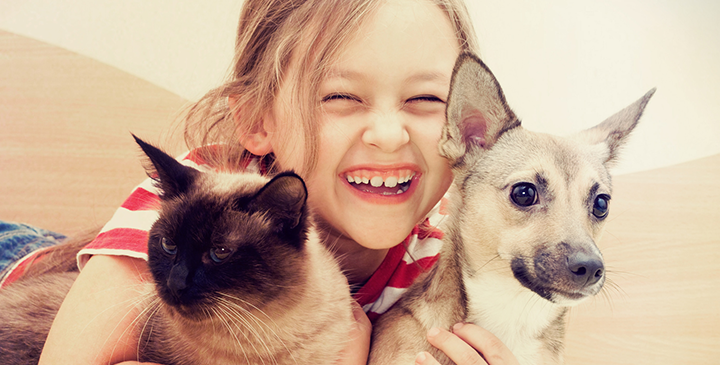Kids and pets go together like peanut butter and jelly, right? Except for when they don’t . . . . Having a pet can be a wonderful addition to your family, but there are a lot of pet myths out there that can make it hard to know if adding a pet to your family is the best decision.
As a pet lover, mom and veterinarian I benefit everyday from my pets and my kids do too. They provide entertainment, vacuum up after messy toddlers, and calm me when I’m exhausted and stressed. There is nothing more ‘zen’ to me than petting a cat. But, I also know many families don’t have good information to take proper precautions so babies and fur-babies can live together harmoniously.
Myth #1
It’s dangerous to be around cats when you are pregnant
Cats can carry a protozoal parasite called toxoplasmosis, and shed it in their stool. Adults and children exposed to this parasite are unlikely to have any ill effects. However, a human fetus can potentially be seriously harmed if the mother is exposed during pregnancy. Women with prior exposure develop antibodies that protect the unborn baby, should she get exposed to toxoplasmosis again while pregnant.
Not all cats have toxoplasmosis. Young cats, sick cats and those that actively hunt are more likely to be a source of the parasite. Actually the most common source of human exposure of toxoplasmosis is soil or raw meat. SO even if you don’t spend any time around cats, you could still be exposed. Simple steps reduce risk of exposure to this parasite. Wash hands and avoid putting them in your mouth, especially while handling raw meat, soil/gardening, and wear gloves when cleaning the litter box. Or better yet, make someone else do it! Who wants to be crouched over on the floor when you have a giant belly or morning sickness, anyway? Talk to your doctor if you have questions or concerns, there are tests that can be run to ensure your unborn baby is not in danger
Dr Emily’s perspective: I was not one of those ‘laid back’ pregnant women, however, armed with knowledge, I was comfortable to continue working as a veterinarian during both of my pregnancies. I handled sick and healthy cats. I was extra cautious about hygiene. I once made a panicked phone call to my Dr after handling a sick kitten, who suspected had toxoplasmosis. My doctor was calm and reassuring, and he ran an extra blood test for peace of mind.
Myth #2
It’s better to get a pet when the kids are older, that way they can take care of it.
It is well documented that a child’s physical, social, emotional and cognitive development can all be encouraged by interaction with the family pet.
They learn many valuable things like; pets need food, water, shelter and exercise; pets are dependent on people for survival, and pets need love and give love unconditionally. Also, learning how to behave safely and comfortably around pets is a valuable life skill.
That being said, identifying a child as the owner and primary caregiver of a new pet can be a recipe for frustration. Younger children are simply not capable and older kids often lack the focus, time, and/or motivation to reliably provide care day in and day out. Realistically, training a new puppy can be overwhelming for an adult! The pet may bond more to a different family member, than the child that ‘owns’ it, resulting in disappointment and loss of interest.
Considering the pet a ‘family pet’ can help reduce frustration in these scenarios. Ultimately, as the adult in the household, getting a new pet is going to require time and financial commitment on your part, no matter how much your child promises and wants to be the caregiver.
Dr Emily’s perspective: Children should be encouraged to get involved in all pet care duties. But when their interest wanes, adult back up is needed. Different kinds of pets have different demands and care requirements. Speak to your veterinarian about a pet choice that would be appropriate for your family. Avoid an impulse pet purchase and do a little research ahead of time to help ensure the addition of a fur baby is great experience for everyone in the household!
Myth #3
My pet doesn’t have worms because his poop looks normal
Lets discuss the real scoop on poop! All puppies and kittens are born with worms, and adult pets are at risk for new exposure all the time. Worm eggs are microscopic and shed in the stool of infected animals. Dogs and cats have evolved to ‘co-exist’ with these parasites, so infected animals can often appear perfectly healthy, with normal looking poop!
Besides being gross to think about these worms can cause disease in people. Children are highest risk because of their immature immune systems; they put objects in their mouth, and possibly don’t have optimal hand washing hygiene!
Worm eggs are very hardy and can survive in the environment (soil, sandboxes, etc) for years; long after evidence of the poop is gone. Wildlife can also be a source of parasite eggs; so practice caution even if you don’t have a pet. Protect your family by hand washing, hand washing and hand washing. Did I mention hand washing? Avoid putting food and objects contaminated with soil in your mouth. Clean up pet stool right away to decrease soil contamination. Keep sandboxes covered. Do not feed wildlife or allow children to play in areas frequented by wildlife. Have your pet checked over by a veterinarian regularly. If you have any questions or are concerned your child has been exposed to worms discuss with your doctor!
Dr Emily’s perspective: Chatham-Kent is a beautiful community. But many of the things I love about it, parasites love too. Mild temperatures, long growing season, high humidity, rural/urban mixed communities. These factors allow parasites to thrive and survive for long periods in the environment. Talk to your vet about a year-round parasite control program for your pets and parasite screening tests. For more information check out www.ckvets.com or www.petsandparasites.org
Myth #4
My pet would never hurt my child
Sometimes love makes us blind. Love for our fur babies is no different! Even the most gentle docile pet has weapons in the form of claws, teeth or just plain old strength and size. Children and pets can make wonderful companions, but should never be left unsupervised together. Instead teach your child and pet how to show affection for each other gently, give your pet opportunities for time outs when the kids are very rambunctious, train your pet to shadow you when you leave the room or have an easy way to separate the kids from the pets when you can’t be in the same room
Dr Emily’s perspective: Baby gates are my favorite invention, ever! Over the last 4 years my house has become an increasingly complex labyrinth of baby gates. Don’t want baby rolling down the stairs? Baby gate! Don’t want the dog’s big nose in the highchair at supper? Baby gate! Want to keep everyone out of the litter box, except the cat? Baby gate!! I can find an excuse to baby gate every stairwell and doorway in my house! Although it makes getting through those areas a little less convenient, it means I can corral the human and fur children much more easily, keep everyone safe(r), and food is much more likely to get eaten by the species it was intended for (cat/dog/human)!



